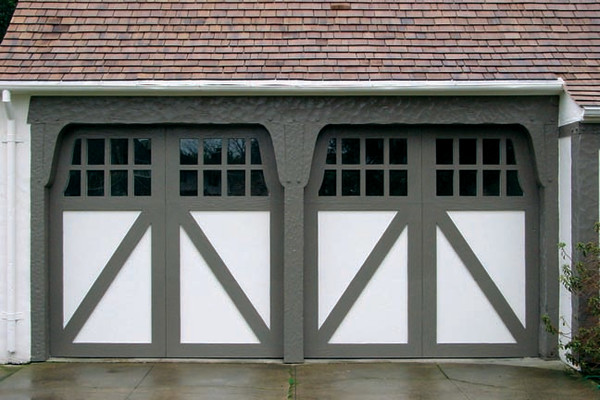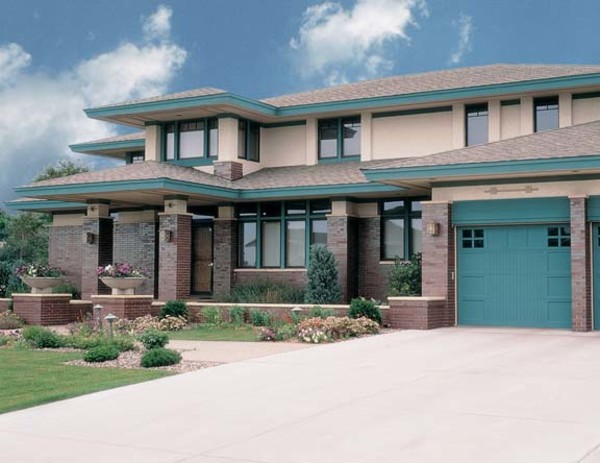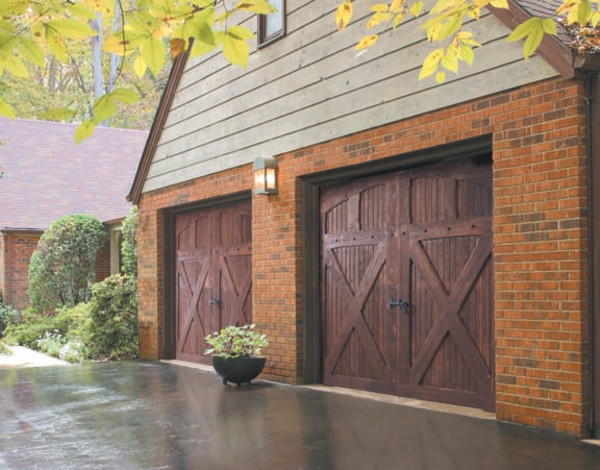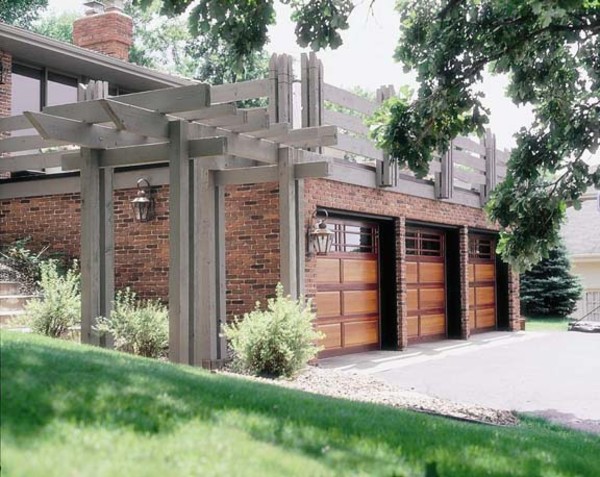From the opening of the auto age, garage doors scored serious style points. Ingenious design also played a big part in vehicular building closures through the first decades of the last century. The point for old-house owners today is that if the entrance to your vintage garage–or a new period garage–is graced by nothing more than a Disco-era roll-up door, it can stand out as a visual mixed message, if not a glaring anachronism. Fortunately, it’s easier than ever to find a period-perfect portal for your flivver, as this primer on historic garage door types and styles shows.
Swing-style garage doors by the Carriage House Door Co.
Swinging Doors
The most prosaic way to open garage doors from 1900 on was to hinge them at their sides in mating pairs, like the proverbial barn doors. Common on multiple and single-car garages and wide by necessity, such doors were often paneled frames reinforced with characteristic diagonal braces to prevent sagging. Modern versions can open traditionally or actually be roll-up doors cleverly designed to look like hinged versions.
Sliding Doors
Garages that accommodated two cars were also big enough for sliding doors—a single large door for each bay. Suspended by a pair of parallel hanger-and-rail systems, one door would pass the other when the bay was opened (inset below). Since these broad doors were top-hung, they could be built with a simple frame backed by edge-matched boards—typically V-jointed. The look of large V-jointed doors is popular today in a variety of opening systems.
Complementary Craftsman doors by Designer Doors
Complementary Designs
According to an early 20th-century text, “Whenever possible, the garage should be constructed to correspond to the residence to which it belongs,” advice that was carried down to the doors as well. Carpenter- or shop-made probably as often as they were ordered from a lumberyard, doors could easily pick up on fenestration patterns or other details in the house, an option possible today with custom and stock doors alike.
Adapted Garages
Well into the 1920s, it was not uncommon to find buildings from other uses repurposed into garages. Barns and similar cultural structures that had become outmoded were typical candidates. Adapted garages might be upgraded with new doors or simply have existing hinged doors retrofitted with more advanced hardware, like and automotive-style roller-and-track system—a conversion heartily endorsed by garage door hardware manufacturers of the day.
Cross-buck garage doors by Amarr
Cross-Buck Doors
The more sophisticated version of the diagonally braced door is the cross-buck door—in essence, diagonal braces running in two directions. A common construction method for side-hinged doors, where it adds structural support against sagging in two directions, it also creates a pleasant visual motif that is reprised in modern garage doors of many types, especially when made of wood.
Door Hardware
The rapid growth of the automobile spawned a demand for private garages, and with it new forms of hardware. Though early garage door hardware, from hangers to locks, was primarily practical, exposed hinge leafs and handles often carried some of the style motifs of their time. Today, many period garage door manufacturers offer decorative (as well as functional) door hardware, and there are hardware manufacturers that can supply specialized hardware, such as heavy-duty hinges.
Top-lighted garage doors by Designer Doors
Top-Lighted Doors
Though early garages were frequently equipped with coveniences from workbenches to radiators to better service their mechanical residents, natural light through doors was always welcome. Panes of glass are rare in side-hinged, swinging doors, but they were common as top lights in sliding doors, often spanning the width of large doors. Broad top lights are just as practical a century later and are historically appropriate—and also available from period garage door manufacturers.
Multiple Doors
One of the most distinctive 1920s garage door patterns was the three-door swinging and sliding combination. Multiple doors often hung from a single track that spanned the entrance, curving back where it meets the side walls. The doors were suspended from swivels and hinged together at their sides so that they fold, accordion style, against an inner wall. Recommended two generations ago for large garages, the multidoor look has found favor again, especially for adding historically appropriate eye relief to contemporary three-car garages.







